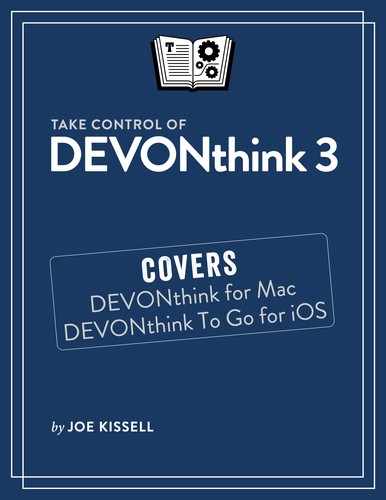Get Information Out of DEVONthink
Ordinarily, you’ll interact with the data in your DEVONthink database using DEVONthink itself. However, in some cases you may want to copy or move documents out of DEVONthink to send to other people or use in other apps. DEVONthink lets you copy, share, or export static information from DEVONthink in a dizzying array of formats to suit almost any need. (If you want to give other people on your local network live access to your database, see the next chapter, Use DEVONthink’s Web Server.)
Copy Data
The simplest way to get a document out of DEVONthink is to drag it to your desktop (or any other convenient folder). You can also drag documents into other appropriate places—for example, you can drag a document into a Mail message to add it as an attachment, drag a graphic into Photos to import it, or drag a text file onto the BBEdit Dock icon to open it for editing in BBEdit.
Another option is to select one or more documents and choose Edit > Copy (⌘-C), then switch to the Finder or another app and choose Edit > Paste (⌘-V).
Export Data
If neither copying nor the Share feature meets your needs, you can export your data in many different formats. You might do this, for example, to save documents in a different format (exporting can convert file formats at the same time), or to create a standalone website from a portion of your database.
All the export commands live on the File > Export submenu, and there are lots of them! (However, not every document format can be exported in every other format—for example, you can’t export a graphic as a text file.) Here are your options:
Document: Saves the selected item in its original format, with the option to add tags in the process.
Files and Folders: Saves selected items in their original formats, preserving any group hierarchy as folders. It’s safest to store exported files and folders in a new folder, rather than intermixing them with existing documents.
as OPML: Exports the selected groups and documents as an Outline Processor Markup Language (OPML) file, suitable for importing into most outliners.
as PDF Document: Exports the selected documents as PDF.
as Rich Text (RTF) Document: Saves selected documents as a single rich text file, including styles but omitting graphics.
as Rich Text (RTFD) Document: Saves selected documents as a single RTFD file, including styles and any graphics.
as Text: Saves selected documents as a single plain text file (that is, without styles); you can optionally specify the encoding using the Text Encoding pop-up menu.
as Unix mailbox: Exports selected email messages (applies only to documents in
.emlor.emlxformat) as a Unix.mboxfile, which many email clients can import.as Word Document: Saves selected documents as a Word (
.doc) file, including styles but not including any graphics.as Website: Saves the selected items as a set of HTML file(s) and linked media, in the process converting non-web-friendly file formats to PDF.
“Website” in this context means a collection of files and folders; by default, DEVONthink doesn’t create an index page. If you want such a page (with links to each of the other documents), click Options in the Save dialog and then select Create Index Pages. This export option can be useful if you have a collection of, for example, rich text documents with embedded graphics and you want to convert it to a format that will display in a webpage (which requires that graphics be stored as separate files).
as Template: Saves the current (single) document as a template in
~/Library/ApplicationSupport/DEVONthink3/Templates.noindex, adding it to the Data > New from Template submenu (for more information, see Template).Database Archive: Saves a copy of the entire selected database, compressed as a Zip file; see Back Up and Restore from Backup.
